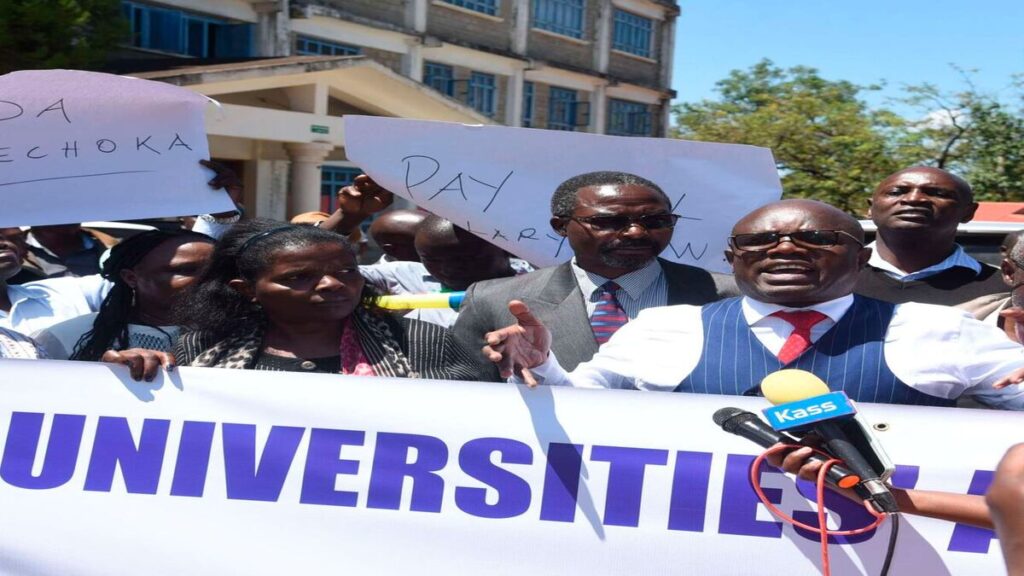The ongoing university lecturers’ strike in Kenya has entered its fourth week. Learning activities remain paralyzed across public universities. The strike began on October 29, 2024, after talks between the University Academic Staff Union (UASU) and the government collapsed.
At the heart of the dispute is a Collective Bargaining Agreement (CBA) signed in September 2024. UASU demands implementation of salary increases ranging from 7 to 10 percent. However, the government’s offer falls short of the union’s expectations.

UASU National Secretary General Dr Constantine Wesonga second (right), joins lecturers during their strike in Eldoret, Uasin Gishu County on August 29, 2024. Courtesy photo
UASU Secretary General Constantine Wesonga has maintained a firm stance. “We cannot accept verbal offers without proper documentation,” he stated during a recent protest march. The union seeks KSh 9.7 billion for salary increments, while the government offers KSh 4.3 billion.
Meanwhile, thousands of students face uncertainty about their academic calendar. Several universities have postponed examinations and graduation ceremonies. This disruption has prompted calls from education stakeholders for semester extensions.
The Labour Court recently intervened in the matter. Justice Agnes Nzei declared the strike unprotected on Tuesday evening. Furthermore, the court directed both parties to resume negotiations immediately.
Despite the court order, UASU members continue their industrial action. They marched to various government offices in Nairobi’s Central Business District on Monday. The protesters sought audience with education and treasury officials.
“Lecturers must receive fair treatment,” Wesonga emphasized during the demonstration. He highlighted concerns about promotion delays, noting that some lecturers remain in one job group for up to 20 years.
The National Assembly’s Education Committee, led by Tinderet MP Julius Melly, has stepped in. However, their efforts to mediate have faced challenges. The Inter-Public Universities Councils Consultative Forum (IPUCCF) has failed to provide crucial documentation.
Government Spokesperson Isaac Mwaura acknowledged the situation’s gravity. He assured that authorities are working towards a solution. Some universities have attempted to continue classes online during the strike.
The agreement in dispute includes several key demands. Besides salary increases, lecturers seek improved medical coverage and pension funding. They also want car loans and mortgage schemes similar to other public servants.
Students have joined their lecturers in solidarity. Many participated in Monday’s protest march from the University of Nairobi. They carried banners demanding immediate implementation of the CBA.
The strike’s impact extends beyond immediate academic disruption. Education experts warn of potential long-term consequences. These include damage to Kenya’s higher education reputation and possible enrollment declines.
Under the proposed deal, lower-grade lecturers would receive a 10 percent raise. Those in higher grades would get a 7 percent increase. Additionally, an annual 4 percent increment on basic salary was promised.
The Labour Court has set November 28, 2024, for further directions. Both parties have 14 days to file their responses to pending motions. This timeline suggests the dispute might extend into December.
UASU leaders insist they will not resume teaching until their demands are met. They argue that the government’s offer lacks transparency and proper documentation. The union remains skeptical of verbal commitments without written proof.
The Ministry of Education faces mounting pressure to resolve the crisis. Student organizations have called for urgent intervention. They fear the prolonged strike might force changes to the academic calendar.
As negotiations continue, the impact grows more severe each day. University administrators struggle to maintain essential services. Graduate students face delays in research supervision and thesis submissions.
The situation highlights broader issues in Kenya’s higher education sector. These include funding challenges and labor relations problems. Education experts call for long-term solutions to prevent future strikes.